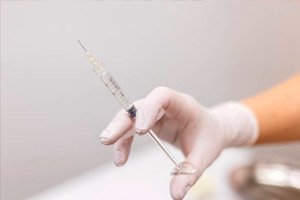
All iLive content is medically reviewed or fact checked to ensure as much factual accuracy as possible.
We have strict sourcing guidelines and only link to reputable media sites, academic research institutions and, whenever possible, medically peer reviewed studies. Note that the numbers in parentheses ([1], [2], etc.) are clickable links to these studies.
If you feel that any of our content is inaccurate, out-of-date, or otherwise questionable, please select it and press Ctrl + Enter.
'One shot and that's it': A shot at birth can provide protection against HIV for many years
Last reviewed: 03.08.2025

A new study published in the journal Nature shows that a single injection of gene therapy at birth could provide years of protection against HIV, exploiting a critical window early in life that could transform the fight against childhood infections in high-risk regions.
The study is one of the first to show that the first weeks of life, when the immune system is naturally more tolerant, may be the optimal window for introducing gene therapies that would otherwise be rejected later in life.
“Almost 300 children are infected with HIV every day,” said first author Amir Ardeshir, an assistant professor of microbiology and immunology at Tulane University’s National Primate Center, who conducted the study with other researchers at the California National Primate Center. “This approach could help protect newborns in high-risk areas during the most vulnerable period of their lives.”
The study injected nonhuman primates with gene therapy that programs cells to continually produce antibodies against HIV. The timing of the injection was critical for a one-time treatment to provide long-term protection.
Those animals treated within the first month of life were protected from infection for at least three years without the need for a booster dose, potentially meaning protection into adolescence in humans. In contrast, those treated at 8 to 12 weeks of age had more developed, less tolerant immune systems that did not respond to the treatment as effectively.
“This is a one-time treatment that coincides with the critical time when mothers with HIV in resource-poor settings are most likely to seek medical attention,” Ardeshir said. “If the treatment is given close to the time of birth, the baby’s immune system will accept it and consider it part of itself.”
More than 100,000 children become infected with HIV each year, mostly through mother-to-child transmission after birth, during breastfeeding. Antiretroviral drugs have been shown to be effective in suppressing the virus and reducing transmission. However, adherence to treatment and access to doctors decline sharply after birth, especially in areas with limited access to health care.
To deliver the treatment, the researchers used adeno-associated virus (AAV), a harmless virus that can act like a delivery truck to deliver genetic code into cells. The virus targeted muscle cells, which are unique in their long lifespan, and delivered instructions for producing broadly neutralizing antibodies (bNAbs) that can neutralize multiple strains of HIV.
The approach solved a long-standing problem with bNAbs. Previous studies had shown that they were effective against HIV, but they required repeated infusions, which are expensive and pose logistical challenges in resource-poor settings.
“Instead, we turn these muscle cells — which live a long time — into mini factories that just keep making these antibodies,” Ardeshir said.
Newborns showed greater tolerance and high expression of bNAbs that successfully prevented infection in simulated breastfeeding and subsequent exposures simulating sexual transmission. Older infants and adolescents were more likely to develop antibodies against the drug that blocked treatment.
The researchers also found that exposing the fetus to antibodies before birth helped older infants accept gene therapy later, avoiding the immune rejection that often occurs with age.
However, Ardeshir said a single injection at birth represents a more cost-effective and feasible solution in real-world settings, while reducing the burden on the mother of repeat visits to the doctor.
Questions remain about how generalizable the findings are to human infants and children, who may be less responsive to treatments delivered via AAV. The study also used a single strain of human immunodeficiency virus, which does not reflect the diversity of HIV strains.
If successful, the treatment could significantly reduce mother-to-child transmission of HIV in high-risk areas such as sub-Saharan Africa, where 90% of all HIV cases in children occur. It could also be adapted to protect against other infectious diseases such as malaria, which disproportionately affects young children in low-income countries.
“Nothing like this could have been achieved even ten years ago,” Ardeshir said. “This is a huge achievement, and now we have all the ingredients to deal with HIV.”
